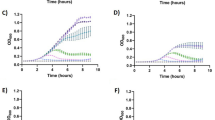Abstract
IT is known that certain antitumour agents are capable of inducing lysogenic bacteria. Thus, Jacob1showed that nitrogen mustard had this property, Gots et al.2reported the same for azaserine, and Otsuji et al.3for mitomycin C. It was thought that this property might afford a relatively simple, rapid and convenient method of detecting potential antitumour agents produced by micro-organisms and might also serve as a suitable assay for following extraction procedures. Accordingly, a quantitative method of measuring the induction of λ phage in E. colistrain K12has been worked out. It consists essentially of inducing a young culture of bacterial cells in M9 medium4for a period of 1 h with the agent and growing the induced cells in nutrient broth for 2¼ h. Phage counts are then done on plates seeded with the indicator strain E. coli, W3001. At the same time, counts are made of the bacteria since it has been found that, when assaying broths which are rich in nutrient materials, growth of the lysogenic strain can lead to increased phage titres and confuse the results of the test. From the results, the induction index, which is the ratio of phage count to bacterial count, is calculated.
This is a preview of subscription content, access via your institution
Access options
Subscribe to this journal
Receive 51 print issues and online access
$199.00 per year
only $3.90 per issue
Buy this article
- Purchase on Springer Link
- Instant access to full article PDF
Prices may be subject to local taxes which are calculated during checkout
Similar content being viewed by others
References
Jacob, F., C.R. Acad. Sci., Paris, 234, 2238 (1952).
Gots, J. S., Bird, T. J., and Mudd, S., Biochim. Biophys. Acta., 17, 449 (1955).
Otsuji, N., Sekiguchi, M., Iijima, T., and Takagi, Y., Nature, 184, 1079 (1959).
Witkin, E. M., Cold Spring Harbor Symp. Quant. Biol., 12, 256 (1947).
Sessoms, S. M., edit. by, Cancer Chemother. Rep., No. 1, 42 (1959).
Author information
Authors and Affiliations
Rights and permissions
About this article
Cite this article
LEIN, J., HEINEMANN, B. & GOUREVITCH, A. Induction of Lysogenic Bacteria as a Method of detecting Potential Antitumour Agents. Nature 196, 783–784 (1962). https://doi.org/10.1038/196783a0
Issue Date:
DOI: https://doi.org/10.1038/196783a0
This article is cited by
Comments
By submitting a comment you agree to abide by our Terms and Community Guidelines. If you find something abusive or that does not comply with our terms or guidelines please flag it as inappropriate.



